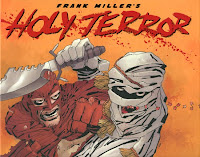4/24/2012
Frank Miller's Holy Terror
"I hope this book really pisses people off... It's a reminder that we are in the midst of a long war. The enemy we are up against is pernicious, deceptive, merciless and wants nothing less than our complete and total destruction." - Frank Miller
I've heard the label "propaganda" attached to Frank Miller's latest graphic novel Holy Terror, his personal response to 9-11. To me, this conjured up old fashioned images of America's overwhelming military might, Captain America socking Adolph Hitler in the jaw, or Chen Zhen kicking the Japanese occupiers in the face to the adulation of Chinese audiences. But Miller's own stylistic predilections don't lend themselves to that kind of obvious flag waving and chest thumping. Anyone familiar with his proficiency with pulp conventions or his libertarian leanings will not be surprised to learn that Holy Terror is a noire revenge fantasy were the resolute anti-hero single-handedly takes down al-Qaeda instead of the usual powerful crime syndicate. There's not a whole lot that's subtle about the premise or in Miller's execution. But one question I had coming to the book is how much of this is meant to be taken seriously as being applicable to the real world?
Reading Miller's own public statements, he seems determined to be taken seriously as a provocateur. His over-the-top approach to storytelling has already split reader opinions down the middle. And that's when he was mainly sneering at superhero tropes. When exercised on actual events, the results are no less controversial. It also makes a literal reading of Holy Terror problematic. The narrative is bare bones - Analogs for Batman (Fixer) and Catwoman (Natalie) go after al-Qaeda after someone commits a suicide bombing. They torture a member for information and infiltrate the enemy lair. They kill them. The end. The bad guys are ludicrous evil archetypes: Cobra Command led by a preening James Bond villain. Unlike the real al-Qaeda, they're well-equipped to launch a succession of rapid, coordinated attacks. Heck, one of the good guys has the Star of David tattooed to his face in case no one could figure out where the book's politics lies. These action movie cliches might make unsympathetic readers roll their eyes at the whole thing. But despite this exaggerated portrayal, Miller's reactionary ideology is evident throughout. One that's underlined by the angry, snarling tone permeating the book. At no point does he distinguish between religious extremists, Islam, or Arabic and Middle Eastern culture in general. Unlike Craig Thompson, he isn't here to understand. He isn't here to bridge cultures. Miller's "postmodern diplomacy" just wants to search and destroy.
And the fantasy of Holy Terror is oddly seductive because Miller's art is more kinetic than 99% of the art found in American mainstream comics. Holy Terror is drawn in the panoramic format that made 300 an effective visual showcase. But the sweeping compositions are contrasted with sometimes awkward figures and some of the ugliest caricatures I've ever seen Miller draw. The ugliness affects both good and evil characters alike. And it's something that blunts the black and white morality of much its supposed propaganda. Actually, the curious experiments in color and odd background details more often seem to be virtuoso display for it s own sake. Not that there's anything wrong with that.
Miller has often referenced his own works and of his colleagues in the past, but Holy Terror's metatexuality seems designed to avoid constructing a complex narrative. It's kind of a lazy shorthand. The emotional resonance of the main characters comes entirely from readers investment in Miller's interpretations of Batman and Catwoman. These characters grunt unoriginal lines like "my city" or "not in my watch". There's the impact of 9-11 itself, the common stereotypes of Muslims and Arabs. And there's the mute portraits of various public figures being counterposed next to panels depicting miscellaneous acts of violence, as if they were ineffectually reacting to these events. The apparent point of relying on these metatextual devices is to facilitate the revenge fantasy. The reader is exposed to familiar images of terrorists doing bad things, then they see Batman going out and killing them.
And in the end, Holy Terror doesn't necessarily deliver a cogent message. On one hand, there's the grim satisfaction of hurting the bad guys who to tried to hurt us. An eye for an eye and all that. But at the very last page is the portrait of a lone man forever terrified by the prospect of fighting an endless war with an enemy he cannot see and cannot understand. He only knows that they want to annihilate his way of life. There doesn't seem to be much hope in this version of the post 9-11 world with a fantasy that both empowers and tyrannizes.




